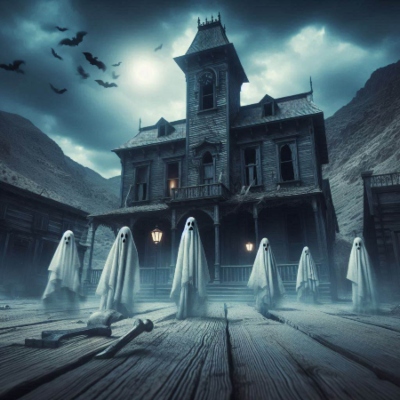What Is a Ghost Town, How Is It Dead And Can It Reborn?
About ten years ago, I followed the love of my life and lived in a city far in the north. That year I studied journalism and took part in a television workshop, where the final assignment was to prepare a few-minute article. So I decided to make a video article that presents the city we lived in as a ghost town. Armed with a camera, a faltering microphone, and a warming jacket, I wandered the streets for several hours. I discovered that, quite unusually, the city’s heart was almost completely deserted. I took long shots that showed the empty streets, focused on a stray dog for the symbolism involved, and interviewed a salesman in an ice cream shop who] made two transactions in three hours. In the closing credits, I added the song “Ghost Town” by the British singer of Georgian origin Katie Malua (“Since you left, I’ve been living in an old ghost town”).
It was clear to me that this city does not meet the definition of a ghost town in the complete sense because people still live there, and tourists visit it. But I made these choices as a critical act about a city with substantial unrealized tourist potential. Since then, this article has come up before me every time I come across or write about a ghost town, a term many people use without knowing what it means or how a town becomes one.
In the following review, we will explain how a ghost city is born, its center of attraction at the tourist level, and what is essential to be careful about when visiting such a city.
What Is A Ghost Town?
When we talk about a ghost town, we mean a city that has been completely – or almost wholly – abandoned by its inhabitants. It is part of the broader term “Ghost Settlement,” although the boundaries are somewhat blurred. The term “Ghost Town” is often used to describe a settlement that does not precisely meet the definition of a city, for example, a town or a village, but one should not be petty. Sometimes we will use the term to describe a city whose population is significantly sparse compared to previous years, even if people live there. Occasionally, our use of the word is critical, mainly to describe a place without any nightlife (sorry, THAT north city just left me traumatized) or things to do so at night you feel like living in a ghost town for real.
This brief overview shows us that a ghost city can become “ghostly” in several situations. As we will immediately see, there are cases in which the town was emptied of inhabitants within a few hours or even less. In other problems, it is a gradual process that can last decades and even hundreds of years due to harmful immigration, precarious living conditions, prolonged epidemics, etc.
Of course, cities can also “lose” this definition if the residents do return to them, as may happen, for example, after recovery from war or after the city’s reconstruction. In other words: a ghost town can be created out of nowhere or gradually, but it doesn’t have to stay that way.

Why Ghost Towns Are Created?
If you go a little deeper, you can see that throughout history, ghost towns were created for several main reasons:
- Wars or military invasions, such as the suburb of Varosha in the city of Famagusta in Cyprus, which people left after the Turkish invasion of Cyprus
- Natural disasters, such as floods (Vija Apcuan in Argentina), Plymouth in the UK (volcano eruption), prolonged coal burning (Centralia in the United States), and more
- Man-made disasters. The prominent examples are the cities of Pripyat and Chernobyl, which were wholly evacuated following the Chernobyl disaster, and the severe nuclear catastrophe in Fukushima, Japan, which occurred due to the earthquake and tsunami that followed. Additionally, some cities were abandoned following mass massacres or even suicides of a significant part of the population
- Diseases that lead to the depletion of the population or moving away from the center of infection. The ghost island of Poveglia in the Venice lagoon is not a city but far from it. The problem is that its grim history and the hundreds of thousands of people who died within its boundaries make it a particularly creepy abandoned place
- Lack of economically sufficient conditions for existence or improved conditions nearby. An example is Chopot Kleh in Crimea, Ukraine, which was almost completely abandoned after the residents received permission to emigrate from it and settle in other Crimean cities. Kolemanskop in Namibia, another example, was a prosperous mining town left due to the depletion of diamond deposits in its vicinity and the discovery of new mines (which explains why many towns became such during The Gold Rush in California, for example).

Every Ghost Town Holds Its Horror
The common denominator of many ghost towns is that they are terrifying. In some of them, you feel as if time has stood still. You get a wild setting that looks like a horror movie location: the abandoned buildings, the takeover of nature as happens quite often, the fact that every sound here may dispel the silence of death, the objects left behind and allow you to imagine the panic that gripped the residents when they tried to their lives Indeed, there were quite a few films that took place in abandoned places. Some of these films were even shot in the exact locations, usually to obtain particular and not obvious permission. In other cases, they try to reconstruct the abandoned place, and sometimes the result is impressive or historically accurate.
Since we are on a site that focuses on the world of horror, it is impossible not to refer to the origin of the name “ghost towns” or to a question that may have arisen for you as well: do ghost towns also have… well – ghosts. We got the impression that the phrase’s origin is unknown, so the question of when exactly they started using it. Moreover, it’s impossible to ignore that some ghost towns have had horror stories attached to them over the years – including encounters with ghosts and other monstrous creatures.
Every ghost story has its origins. Human imagination seems to work overtime in such places; what’s more, sometimes, the prevailing conditions explain some of these “visions.” In Centralia, Pennsylvania, for example, there has been continuous burning of coal for decades, which explains why people call this place a “hell on earth.” Today, we know that exposure to vast amounts of carbon dioxide can disrupt the activity of the brain and nervous system and cause, among other things, hallucinations.
This is a reason why people who have come to this abandoned town and other old and abandoned places talk about the appearance of demons and evil spirits, hearing strange screams and noises, and other potential horror movie scenes. There are cases where these myths began to emerge for various reasons or even for touristic purposes.
Here is a short video presenting “Real” haunted ghost towns in United States:
Ghost Cities Tourism: You Can Visit, But It’s Essential To Be Careful
Unsurprisingly, and as can be deduced from the fact that abandoned places are part of the broader world of horror tourism, there is a very high demand for visiting some ghost towns around the world. It certainly makes sense. These places are breathtaking in most cases, historically fascinating, and a paradise for photographers and cultural researchers. Some of these ghost towns are a short drive from sought-after tourist destinations, so getting there can be pretty simple and require no more than a few hours of your time.
However, we must remember that visiting some of these ghost towns can be dangerous. Sometimes there is a tangible danger for visitors, for example, the collapse of buildings or abnormal levels of radiation that requires obtaining a special permit for a visit (which is not evident that the average tourist would receive).
Therefore, the clear recommendation is to find out carefully whether and under what conditions it is possible to tour the ghost towns that interest you. In most cases, you will be happy to hear that there are tours or day trips to these cities, accompanied by a guide who can explain everything essential to know about the cities and how they became “dead.” From our experience, this type of tour – when it is successful and done by a guide who has lived the story – can significantly upgrade the background… and also save your life.
Some of the links on this site are affiliate links. That means if you purchase through them, we might earn a small commission. But don’t worry... it won’t cost you extra, and it probably won’t summon anything...
So if you’re thinking of buying something… don’t be afraid to click! 🔪👁️





